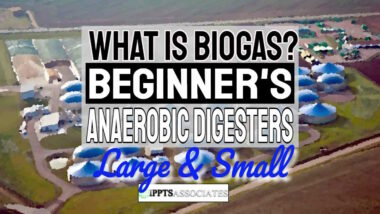In his case study, we explain how a Landia Digester Mixing System has raised all-important biogas output by 20%. This improvement has been maintained for over 2 years since installation and has enabled Downers Grove Wastewater Treatment Center to become 100 percent net energy neutral.
Press Release (18 January 2020):
Landia Digester Mixing System Increases Major Wastewater Treatment Center’s Biogas by 20%
 At the multi-award-winning Downers Grove Wastewater Treatment Center in Illinois, Landia’s GasMix digester mixing system has increased biogas production by approximately 20%.
At the multi-award-winning Downers Grove Wastewater Treatment Center in Illinois, Landia’s GasMix digester mixing system has increased biogas production by approximately 20%.
The enhanced mixing of the digester by the externally-mounted Landia system has also increased the destruction of volatile solids from approximately 55 to 65% VS destruction.
Two years on since it became the first municipality in North America to introduce Landia’s GasMix technology, Downers Grove no longer has to flare off any gas, achieving optimum mixing and the lowest possible parasitic load from a system that runs for just 12 minutes per hour.
Downers Grove’s General Manager, Nicholas Menninga, commented:
“For our primary digester, we’d had issues for years with a compressor, which wouldn’t really move the gas as we wanted it to. After looking at several options as a replacement, the Landia GasMix was the most cost-effective option, and was a straightforward retrofit”.

Installed on Downers Grove’s 460,000-gallon primary digester, the Landia GasMix sees an external 49 hp Landia chopper pump draw sludge from the digester, reducing particle size before pumping through an aspirating venturi nozzle.
The resulting vacuum sucks biogas down from the headspace of the digester as gas is injected into the liquid, mixing the sludge vertically and preventing a layer of scum or crust from forming on the surface.
A high-pressure mixing nozzle then injects liquid into the lower half of the digester, creating a horizontal, rotational mixing pattern that prevents heavier solids from settling, thus mixing the whole tank and not just parts of it.
The solids content and characteristics of the sludge are set up so that it determines the operation time of each valve for optimum mixing performance and energy efficiency.
Nicholas Menninga added:
“With the Landia GasMix there are no moving parts inside the digester, so it is very easy to maintain. By continuously reducing the particle size, the low-viscosity sludge helps reduce surface scum. This not only makes the whole system run more efficiently, but significantly increases the volume of active digestion and therefore the gas yields.
“From sizing up the equipment for our primary digester to installation and optimization, we’ve also had very good support from Landia throughout,”
he said.
The energy-efficient mixing solution, together with the on-site generation of electricity from a Nissen CHP unit (and other energy-efficiency improvements) has enabled Downers Grove Wastewater Treatment Center to become 100% net energy neutral.
The anaerobic digesters at the Center process a mixture of primary sludge, waste-activated sludge, and FOG co-digestion.
In addition to Downers Grove, the Landia GasMix system has been installed in numerous municipal and industrial digesters all over the world, including biogas plants using food waste and/or agricultural slurries and other high-solids feedstocks.

Landia Digester Mixing to Increase Biogas Output
The biogas business is expanding rapidly, and biogas is becoming a more popular form of renewable energy. A biogas plant works by decomposing organic materials to produce biogas, which is then utilised to generate energy.
The capacity to extract the maximum quantity of biogas from the feedstock is a critical aspect of the success of a biogas plant. The Landia Digester Mixing system is a device designed to boost the biogas output of biogas facilities.
What exactly is a Landia Digester Mixing System?
The Landia Digester Mixing System is a proprietary mixing system specifically intended for use in anaerobic digesters. The system comprises a mixer inserted in the digester that rotates and mixes the digester's contents. The mixer is designed to maintain the optimum temperature, pH, and nutrition levels within the digester by creating a constant flow of materials. This guarantees that the bacteria responsible for decomposing organic materials may operate efficiently, resulting in increased biogas generation.
What is the Landia Digester Mixing System?
The Landia Digester Mixing system generates a vortex within the digester. This vortex causes a flow of materials within the digester, which aids in the maintenance of proper temperature and pH levels. The mixer also aids in breaking up any clumps of material within the digester, allowing the bacteria to break down organic materials more efficiently.
The Landia Digester Mixing system is meant to be very efficient and power efficient. The mixer is powered by a motor designed expressly for use in tough locations, ensuring that it can resist the conditions inside the digester.
What are the Advantages of Using the Landia Digester Mixing System?
It has been demonstrated that the Landia Digester Mixing system greatly increases the biogas output of biogas plants. According to studies, the device can improve biogas output by up to 30%, resulting in a significant increase in energy generation. The system is also extremely reliable and has a long lifespan, making it a cost-effective alternative for biogas plant operators.
The Landia Digester Mixing system provides additional advantages in addition to increasing biogas generation. The technology helps to reduce the amount of digester maintenance required by preventing solids buildup within the digestion. This means less downtime for maintenance, which leads to increased energy output.
Conclusion
The Landia Digester Mixing system is a technology designed primarily to increase biogas output in biogas facilities. The system is extremely efficient, dependable, and cost-effective, making it an excellent investment for biogas plant operators. With the growing demand for renewable energy, technologies like the Landia Digester Mixing system will be critical in meeting that demand.
[Originally posted 20 January 2020. Updated April 2023.]




